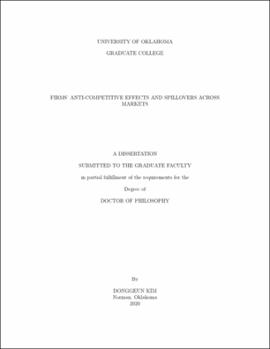| dc.contributor.advisor | Liu, Qihong | |
| dc.contributor.author | Kim, Donggeun | |
| dc.date.accessioned | 2020-12-17T15:59:06Z | |
| dc.date.available | 2020-12-17T15:59:06Z | |
| dc.date.issued | 2020-12-18 | |
| dc.identifier.uri | https://hdl.handle.net/11244/326632 | |
| dc.description.abstract | The first chapter is a joint paper with my committee member as well as my mentor, Dr. Myongjin Kim and Dr. Kerry Tan Loyola from University Maryland. We study the impact of tacit collusion on price dispersion in the U.S. airline industry. We find that tacit collusion driven by multimarket contact has a positive effect on prices, but a negative effect on price dispersion. Our empirical results suggest that airfares throughout the price distribution increases, yet the price distribution becomes more compressed since 10th percentile airfares increase by a larger amount than 90th percentile airfares. Moreover, we also find that this pricing phenomenon does not exist if Southwest Airlines is present on the route. Thus, route-level price competition is softened when the same airlines directly compete more frequently, except when Southwest Airlines services that route. As such, our empirical analysis provides evidence that the presence of Southwest Airlines exhibits an anti-collusive effect.
Chapter 2 is a joint work with my mentor, Dr. Myongjin Kim and Dr. Qi Ge from Vassar College. This paper examines US airline mergers between 1993 and 2018 and studies their impact on the labor market. Our difference-in-differences estimates indicate a significant reduction in the merging airlines' long-term wage and fringe benefits following the mergers. The effect is particularly salient among large-scale mergers involving major airlines and low cost carriers. The results also suggest a negative short-term employment impact of mergers that varies by occupation types. Our findings are consistent with the impact of merger-induced monopsony power discussed in recent literature and offer important policy implications regarding how to account for employer monopsony power during mergers and acquisitions.
In the third chapter which is a joint work with my best friends, Brent Norwood and Sean O'Connor, we identify the cross and inter-state effects of marijuana legalization on house prices using a national housing data set from the online real estate listing database Zillow.com. We find positive effects upwards of ten percent in the top half of the price distribution following successful legalization ballot initiatives, and between five and fifteen percent across the distribution after the state enacts the ballot initiative and the first legal sales take place. A spatial difference-in-differences model reveals that within Colorado and Washington, prices in neighborhoods with new dispensary openings nearby experience a seven percent price appreciation. To summarize, our results suggest that there are second order benefits to marijuana legalization. | en_US |
| dc.language | en_US | en_US |
| dc.subject | Industrial Organization | en_US |
| dc.subject | Applied Microeconomics | en_US |
| dc.subject | Airline Industry | en_US |
| dc.title | Firms’ anti-competitive effects and spillovers across markets | en_US |
| dc.contributor.committeeMember | Kim, Myongjin | |
| dc.contributor.committeeMember | Kosmopoulou, Georgia | |
| dc.contributor.committeeMember | Burge, Gregory | |
| dc.contributor.committeeMember | Ingene, Charles | |
| dc.date.manuscript | 2020-12-14 | |
| dc.thesis.degree | Ph.D. | en_US |
| ou.group | College of Arts and Sciences::Department of Economics | en_US |
| shareok.orcid | https://orcid.org/0000-0001-7774-5957 | en_US |
